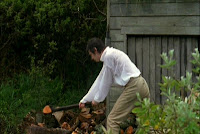When I was growing up in North Jersey, ten miles off the George Washington Bridge, I was surrounded by newspapers. Every morning, my father bought two newspapers: The New York Times (he loved the puzzles and the brain food) and The Daily News (he followed the races at Monmouth and Aqueduct Racetracks). On the way home from school, I picked up The New York World Telegraph for an invalid spinster who lived in our apartment complex. There was also the Journal American, The Post, Herald Tribune, The Sun, and various ethnic newspapers as well.
My mom worked the night shift at a bank, and when she got home from work around midnight, she would read The Paterson Evening News—every darn article in the paper—even though she had to get up at 6:00 in the morning to get her six kids off to school.
At that time, New Jersey had “the blue laws,” that is, no stores were allowed to be open on the Sabbath. For Christians, that was Sunday; for Jews, it was Saturday, which meant that the only store open on Sunday was the Jewish candy store. That was where, every Sunday after Mass, we bought
The Newark Star Ledger. Before we had a car, we had to carry this ten-pound paper home. As soon as we got in the door, the paper would be dismembered as everyone went for their favorite section. (Mine was the Parade insert.)
The Star Ledger was a part of my childhood, adolescence, and early adulthood. So you can imagine how pleased I was when
Mr. Darcy’s Bite was reviewed by
The Ledger. Without further ado, here is the review:
This book is written with enough originality, whimsy and respect for Jane Austen’s style to make it stand out in the crowded field of Austen genre mash-ups. Simonsen revisits Darcy and Elizabeth’s tempestuous courtship and provides an explanation for Darcy’s erratic behavior: He’s a werewolf. Bitten on a childhood sojourn in Europe, Darcy has guarded his secret: He transforms at the full moon.
Because Simonsen carefully imagines how a werewolf nobleman would adapt to society and how that would play out with Austen’s characters, the story works as earnest rather than camp. After Darcy reveals his nature to Elizabeth, she must decide whether she still loves him. Simonsen’s characterizations are faithful to Austen, but engagingly playful with the possibilities of a werewolf double-life. His werewolf nature connects Darcy to the passions of the natural world, letting Simonsen ratchet up the couple’s romance. The classic love story between Elizabeth and Darcy holds firm, even if things do get a little hairy once a month.
I have not lived in New Jersey since 1977, but I have fond memories of The Garden State. So this review is something of a homecoming for me, and I’m pleased as punch that a fellow Jerseyite liked my story.















 I love a good historical mystery, especially if the author has successfully recreated the era in which the story takes place. The Black Tower by Louis Bayard is just such a book . Dr. Hector Carpentier is drawn into a web of intrigue when his address is found on a note in the pocket of a murder victim. Carpentier doesn’t know Henri LeClerc—yet. But when Paris detective Vidocq shows up at his door, he is about to find out who the deceased is. Vidocq is the master of disguise, and he needs every one if he is to find out if Louis Charles, the son of Louis XVI and Marie Antoinette, survived the abuse and neglect of his guards in the Temple’s Black Tower during the French Revolution. Because if he did, he is France's rightful king.
I love a good historical mystery, especially if the author has successfully recreated the era in which the story takes place. The Black Tower by Louis Bayard is just such a book . Dr. Hector Carpentier is drawn into a web of intrigue when his address is found on a note in the pocket of a murder victim. Carpentier doesn’t know Henri LeClerc—yet. But when Paris detective Vidocq shows up at his door, he is about to find out who the deceased is. Vidocq is the master of disguise, and he needs every one if he is to find out if Louis Charles, the son of Louis XVI and Marie Antoinette, survived the abuse and neglect of his guards in the Temple’s Black Tower during the French Revolution. Because if he did, he is France's rightful king.

 I love English. I love grammar. Even when I get it wrong (dangle a particple, don't use an antecedent, run-on sentence), I love learning about the nuts and bolts of English. If you attended a Catholic school in the 1950s and '60s as I did, then you know how to diagram a sentence, that is, breaking a sentence down into its component parts so that you know how a sentence goes together. It was boring, but necessary, and it has served me well.
I love English. I love grammar. Even when I get it wrong (dangle a particple, don't use an antecedent, run-on sentence), I love learning about the nuts and bolts of English. If you attended a Catholic school in the 1950s and '60s as I did, then you know how to diagram a sentence, that is, breaking a sentence down into its component parts so that you know how a sentence goes together. It was boring, but necessary, and it has served me well.



















